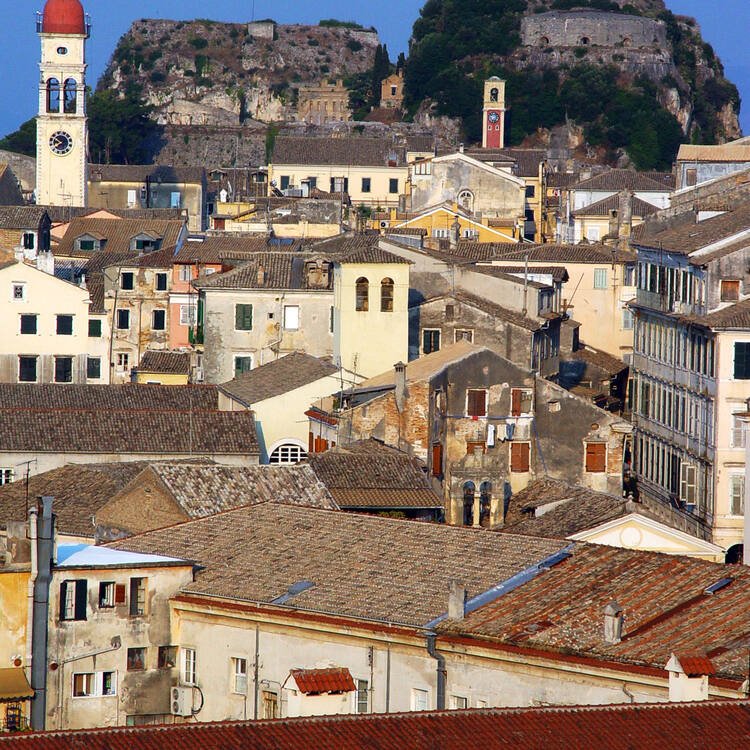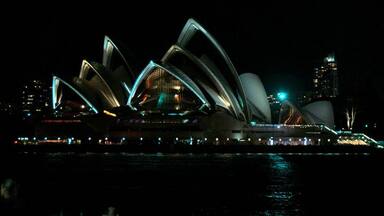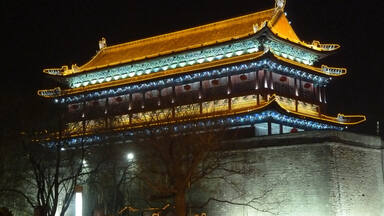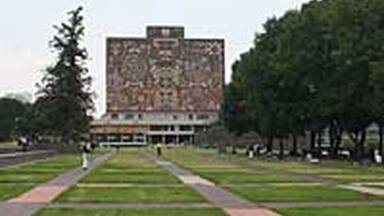Old Town of Corfu
Old Town of Corfu
The Old Town of Corfu, on the Island of Corfu off the western coasts of Albania and Greece, is located in a strategic position at the entrance of the Adriatic Sea, and has its roots in the 8th century BC. The three forts of the town, designed by renowned Venetian engineers, were used for four centuries to defend the maritime trading interests of the Republic of Venice against the Ottoman Empire. In the course of time, the forts were repaired and partly rebuilt several times, more recently under British rule in the 19th century. The mainly neoclassical housing stock of the Old Town is partly from the Venetian period, partly of later construction, notably the 19th century. As a fortified Mediterranean port, Corfu’s urban and port ensemble is notable for its high level of integrity and authenticity.
Description is available under license CC-BY-SA IGO 3.0
Vieille ville de Corfou
La vieille ville située sur l’île de Corfou, au large des côtes occidentales de l’Albanie et de la Grèce, occupe une position stratégique à l’entrée de la mer Adriatique. Le début de son histoire remonte au VIIIe siècle av. J.-C. Les trois forts de la ville, conçus par des ingénieurs vénitiens renommés, ont servi pendant quatre siècles à défendre les intérêts du commerce maritime de la République de Venise contre l’Empire ottoman. Au fil du temps, ces fortifications durent être réparées et partiellement reconstruites à plusieurs reprises, les travaux les plus récents ayant été réalisés au XIXe siècle sous la domination britannique. Les bâtiments de la vieille ville, pour la plupart de style néoclassique, datent en partie de la période vénitienne et en partie d’époques plus tardives, notamment du XIXe siècle. Corfou, ville portuaire fortifiée de la Méditerranée, est exceptionnelle par son intégrité et son authenticité.
Description is available under license CC-BY-SA IGO 3.0
مدينة كورفو القديمة
تقع المدينة التاريخية في جزيرة كورفو، على مسافة من السواحل الغربية الألبانية واليونانية، وتشكل موقعاً استراتيجياً عند مدخل البحر الأدرياتيكي. كما أن جذورها تعود إلى القرن الثامن قبل الميلاد. وقد صمدت الحصون الثلاثة للمدينة، التي صممها مهندسون مشهورون من البندقية، طوال أربعة قرون للدفاع عن المصالح التجارية البحرية لجمهورية البندقية ضد الامبراطورية العثمانية. وأصلحت الحصون على مرّ الزمن وأعيد بناؤها جزئياً عدة مرات، لا سيما إبان الحكم البريطاني في القرن التاسع عشر. وترقى البنى النيوكلاسيكية المنتشرة في المدينة القديمة إلى الحقبة الإيطالية (البندقية) في جزء منها، في حين أن البعض الآخر يعود إلى فترة لاحقة، وتحديداً إلى القرن التاسع عشر. ويُعدّ مرفأ كورفو المحصَّن من أبرز المرافئ المتوسطية لما يتصف به من وحدة في البناء وأصالة رفيعة.
السيدة النبيلة وكراسي البلاستيك رسالة اليونسكو (2007)
source: UNESCO/CPE
Description is available under license CC-BY-SA IGO 3.0
科孚古城
科孚古城起源于公元前8世纪,位于希腊西海岸的科孚岛,与阿尔巴尼亚隔海峡相望,占据了亚得里亚海入海口的战略位置。古城的三座要塞由著名的威尼斯工程师设计,在400多年里被威尼斯共和国用来保护海上贸易利益,抵抗土耳其帝国。时光荏苒,19世纪英国统治时期,要塞历经多次修缮,并部分重建。在古城的新古典主义建筑当中,有一部分建于威尼斯统治时期,另有一部分是后建的,主要为19世纪建筑。作为地中海的港口要塞,科孚城区和港口建筑群因高度完整、保存良好而闻名于世。
source: UNESCO/CPE
Description is available under license CC-BY-SA IGO 3.0
Древний город Корфу
Древний город на острове Корфу, расположенном по соседству с западным побережьем Албании и Греции, занимает стратегическое положение при входе в Адриатику. Его история берет начало в VIII в. до н.э., когда Венецианская Республика построила здесь три форта, которые в течение четырех столетий защищали ее морские торговые суда от нападений Оттоманской империи. Со временем эти фортификационные сооружения неоднократно ремонтировались и частично перестраивались. Старинные здания города, в основном неоклассического стиля, относятся к венецианскому периоду и к более поздним временам, в частности, к XIX в. Средиземноморский город-крепость Корфу – уникален своим ансамблем и подлинностью сохранившихся строений.
source: UNESCO/CPE
Description is available under license CC-BY-SA IGO 3.0
Ciudad vieja de Corfú
Situada en la isla de su mismo nombre, frente a las costas de Albania y Grecia, la ciudad vieja de Corfú ocupa una posición estratégica a la entrada del Mar Adriático. Posee vestigios arqueológicos que datan del siglo VIII a.C. También cuenta con tres fortificaciones diseñadas por ingenieros venecianos, que durante cuatro siglos sirvieron para defender los intereses del comercio marítimo de la República de Venecia contra el Imperio Otomano. Con el correr del tiempo, las fortificaciones fueron reparadas y parcialmente reconstruidas en varias ocasiones. Las últimas obras fueron realizadas en el siglo XIX, en tiempos de la dominación británica. Los edificios de la ciudad vieja son en su mayoría de estilo neoclásico. Algunos datan de la dominación veneciana y otros de épocas más tardías, en particular del siglo XIX. La integridad y autenticidad de la vieja Corfú hacen de ella un ejemplo excepcional de ciudad portuaria fortificada del Mediterráneo.
source: UNESCO/CPE
Description is available under license CC-BY-SA IGO 3.0
コルフ旧市街
source: NFUAJ
Oude stad Corfu
Source: unesco.nl
Outstanding Universal Value
The ensemble of the fortifications and the Old Town of Corfu is located in a strategic location at the entrance to the Adriatic Sea. Historically, its roots go back to the 8th century BC and to the Byzantine period. It has thus been subject to various influences and a mix of different peoples. From the 15th century, Corfu was under Venetian rule for some four centuries, then passing to French, British and Greek governments. At various occasions, it had to defend the Venetian maritime empire against the Ottoman army. Corfu was a well thought of example of fortification engineering, designed by the architect Sanmicheli, and it proved its worth through practical warfare. Corfu has its specific identity, which is reflected in the design of its system of fortification and in its neo-classical building stock. As such, it can be placed alongside other major Mediterranean fortified port cities.
Criterion (iv): The urban and port ensemble of Corfu, dominated by its fortresses of Venetian origin, constitutes an architectural example of outstanding universal value in both its authenticity and its integrity.
The overall form of the fortifications has been retained and displays traces of Venetian occupation, including the Old Citadel and the New Fort, but primarily interventions from the British period. The present form of the ensemble results from the works in the 19th and 20th centuries. The authenticity and integrity of the urban fabric are primarily those of a neo-classical town.
The responsibility for protection is shared by several institutions and relevant decrees. These include the Hellenic Ministry of Culture (ministerial decision of 1980), the Ministry of the Environment, Spatial Planning and Public Works (Presidential decree of 1980) and the Municipality of Corfu (Presidential decree of 1981). Also relevant are: the Greek law on the shoreline of towns and of islands in general; the law on the protection of antiquities and cultural heritage in general (n° 3028/2002) and the establishment of a new independent Superintendence for Byzantine and post-Byzantine antiquities, in 2006. A buffer zone has been established. The proactive policies of restoration and enhancement of the fortifications and of the citadel have resulted in a generally acceptable state of conservation. Many works however have still to be completed or started. A management plan has been prepared. An urban action plan, which is in line with the management plan of the nominated property, has just been adopted (2005) for the period 2006-2012.

 View photos from OUR PLACE the World Heritage collection
View photos from OUR PLACE the World Heritage collection



